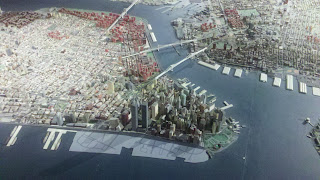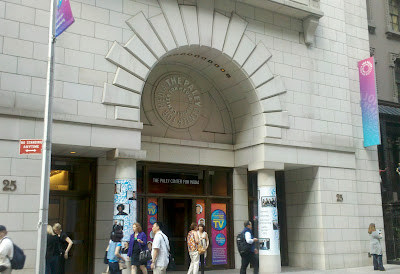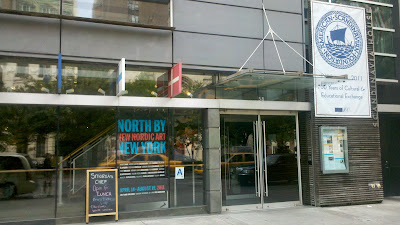 |
| Japanese Tree Peony Garden, with flowers the size of melons |

My favorite flower is the peony--the "king of flowers." And currently the Brooklyn Botanic Garden (BBG) Japanese Tree Peony Collection (a gift from the people of Yatsuka, Simane Prefecture, Japan after September 11, 2001) is in full bloom and glorious. I know if I had gone to the BBG in the last week or two, I could have caught the cherry blossoms at their height, but to me, well, nothing beats a peony. I took an inordinate number of peony pictures (with which I will not bore you all--ok, just one more--see right), but really, I just kept turning around and seeing yet another bloom that was too gorgeous for words. You can check what is currently in bloom at
BBG's Current Blooms.

I also took the time to check out the BBG's website to see if there were any events or tours that I could join, and lucky for me, in celebration of
NYC Wildflower Week and in honor of it's 100 year anniversary, curator/gardener Uli Lorimer led a free tour of the Native Flora Garden, highlighting indigenous flowers and plants, such as the aquatic Golden Club (
Orontium aquaticum) (see left) and the yellow lady-slipper (once plentiful but now rare due to human and deer activity), that are native to the 100 mile radius of NYC. Uli gave us an up-close and personal view of some amazing local plants, cutting some samples and letting us hold and smell plants like the Shooting Star (which shoots out pollen at a force of up to 30 Gs when certain bees hit the right chords) (see right).

He also showed us the Solomon's Seal (which smelled like soap) (see photo at left of plant branch and row of flowers turned upside down); the May Apple (which spread through rhizomes and had cute, round flowers under big flat leaves (see right); and the Squaw Root (which is a parasitic plant that lives off of the sugars created by neighboring trees and that is only visible above ground in the spring in time to drop seeds from their yellow cones).

He also pointed out some endangered plants like the S1 (meaning fewer than 5 exist in the state) Coast Violet (see left), a recently (April 2011) fallen Scarlet Oak that died after being weakened by fungal disease, as well as the BBG's oldest tree, which is a 125 year old magnificently gnarled Black Cherry (see right).
After the hour-long tour, I took the garden map and went through most of the highlights of the 52 acre garden. In addition to my favorite tree peonies, the Louisa Clark Spenser Lilac Collection was in full splendor as were the Annual Border of tulips (some of which were the size of my palm!). Also worth a long meander was the Japanese Hill-and-Pond Garden (with its ducks, turtles, and carp) and the Osborne Garden (with its formal Italian, wisteria-draped pergolas) (see above left).
I also thought that the BBG was particularly innovative with the way they featured fragrant plants in raised beds for the visually impaired to read about in braille and touch and smell. They also creatively displayed over 80 flowers, herbs and trees in the Shakespeare Garden with poetry or quotes from Shakespeare's works that featured these plants (see right).
My tour ended with the Steinhardt Conservatory, which shows over 8,000 plants grown in climate controlled desert, tropical, aquatic, and warm temperate pavilions as well as a special bonsai museum (the oldest one I saw was 310 years old!). Well actually my visit ended with a little plant shopping in one of the two gift/plant shops where I purchased air plants (yes, no dirt needed), which were highlighted in the tropical pavilion and a succulent, which was shown in the desert pavilion.

While the three subways is a bit much for me (I probably won't go back any time soon unless I'm invited to a wedding there or I decide to visit the Brooklyn Museum, which is at the same subway stop), I will say that if it was just a little more convenient I would seriously consider taking one or more of the several classes the BBG offers. Classes are offered in, among other things, floral arranging, landscape painting (Can you imagine a more inspiring locale?--see photo above left of Japanese Hill-and-Pond Garden), poetry writing, composting, plant identification, drawing, tai chi, and, of course, gardening. Definitely worth a look, visit
BBG Classes.


 When I got to Wave Hill, I first went on a 45 minute tour at the Glyndor Gallery. They are currently displaying the work of three artists, Philip Taaffee, Fred Tomaselli, and Terry Winters, who have been inspired by nature and created numerous pieces for the Glyndor Gallery. Taaffee used screen printing, collage, and marbling washes to create layered pieces with direct references to sea life and indirect references to cacti. Tomaselli layered collage from magazines and catalogs as well as resin and acrylic paint to create transformational and accessible psychedelic art pieces (see "Dahlia" above left and bird images created using outerwear clothing catalog images at right). Winters does more abstract work that only references the balance of flowers in nature in his series of Hexagrams in oil, collage, and embossing.
When I got to Wave Hill, I first went on a 45 minute tour at the Glyndor Gallery. They are currently displaying the work of three artists, Philip Taaffee, Fred Tomaselli, and Terry Winters, who have been inspired by nature and created numerous pieces for the Glyndor Gallery. Taaffee used screen printing, collage, and marbling washes to create layered pieces with direct references to sea life and indirect references to cacti. Tomaselli layered collage from magazines and catalogs as well as resin and acrylic paint to create transformational and accessible psychedelic art pieces (see "Dahlia" above left and bird images created using outerwear clothing catalog images at right). Winters does more abstract work that only references the balance of flowers in nature in his series of Hexagrams in oil, collage, and embossing. 













































